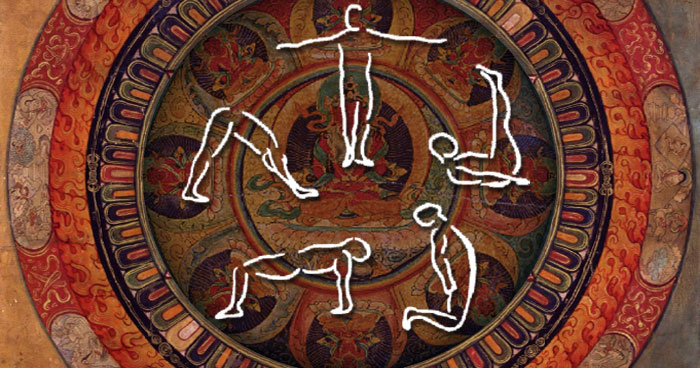Book Appointment Now

5 Tibetan Rites
The 5 Tibetan Rites are an ancient daily practice to build vital energy (prana, chi) and power that consists of a sequence of five exercises performed 21 times. People perform these rites with the intention of restoring youth and increasing vitality.
The Five Tibetan Rites, created by Tibetan lamas (monks), are thought to be more than 2,500 years old. Traditionally known as the “Fountain of Youth” they are thought to restore a person’s vitality and strength.
Based on the body’s energy, the Five Tibetan Rites are essentially a condensed form of yoga that powers up the chakras, heals and strengthens the body and balances the body’s systems. Also known as the endocrine system, a network of glands and organs that regulate many of the body’s functions, including the aging process.
The major endocrine glands include the pineal, pituitary, pancreas, ovaries, testes, thyroid, parathyroid, hypothalamus and adrenals. The hormones secreted by these glands affect all the organs in the body and, therefore, many of the body’s systems (digestion, reproduction, growth, etc.).
The Chakra System
 In terms of Chakra, what gives the 5 Tibetan Rites their power is there positive effect on the ‘spin’ of the chakras. In getting the chakras spinning well (activated or energized) you feel better and more balanced – mentally, emotionally and physically.
In terms of Chakra, what gives the 5 Tibetan Rites their power is there positive effect on the ‘spin’ of the chakras. In getting the chakras spinning well (activated or energized) you feel better and more balanced – mentally, emotionally and physically.
If our energy centers or chakras are healthy and in balance the corresponding endocrine glands are affected positively.
Benefits of the Five Tibetan Rites
Benefits reported to be expected include:
- improved sleep;
- relief from stiffness and body pain, especially joints;
- improved spinal health and relief of arthritis symptoms;
- weight loss; reversal of aging symptoms or ‘youth-ing’;
- improved physical strength and endurance;
- emotional and mental health improvements and better memory;
- greater sense of well-being and balance; and better energy throughout your day.
So this simple practice can be the key to vibrant health.
Added benefits are the minimum daily time requirement off between 5 and 20 minutes or so, depending on how slowly you breathe and how many repetitions of each Rite you do. The minimum space required — just a body’s length or size of a mat. And no special equipment needed, so it’s an easy practice for any time or any place.
The 5 Tibetan Rites
Like all exercise programs, the 5 Tibetan Rites should be done with care. Start with gentle movements and a low number of repetitions.
While each rite is meant to be practiced 21 times, you can begin by doing them less repetitions. Then add 2 repetitions per rite the following week. Continue adding 2 reps per rite each week until you’re doing 21 rounds of each rite every day.
While practicing the rites each morning may be enough, you may want to try doing them 3 times a day.
Some helpful hints and suggestions are :
- Perform the rites on an empty stomach.
- Do them first thing in the morning, as it will boost your metabolism and energy.
- Practice them daily, but take a day off occasionally if you need to.
- Don’t shower right after, as it will dissipate the vital energy that you built during the practice.
- Perform them in a ventilated shaded area – outdoors if possible.
- Move at a slow pace, using strength, control and breath to set the pace. Not momentum.
- Do the five rites in the given order.
- Don’t rush and don’t strain. Be patient and build up slower if needed.
- Focus on doing each exercise correctly – not on speed.
- Follow the recommended breathing pattern for each movement. Keeping the breathing full and continuous.
- Take two cleansing breaths between each rite. (Full breath in through the nose, complete breath out through the mouth)
- If you’re short on time, do fewer repetitions. (This is preferable to skipping a day)
How to do the 5 Tibetan Rites
 Breathe, taking two cleansing breaths between each Rite
Breathe, taking two cleansing breaths between each Rite
Stand with feet about hip width apart
Hands rest on hips
Inhale deeply through your nose
Exhale fully through your mouth, making an ‘o’ with your lips
The purpose of this short interlude is to give your body a chance to absorb and integrate what it has just experienced. Do this after each Rite.
Rite 1 : Spinning
Spinning, with arms outstretched, palms facing down, standing tall and turning slowly around in a circle.
Stand up straight. Stretch your arms outward until they’re parallel with the floor. Face your palmsdown.
While staying in the same spot, slowly spin your body in a clockwise direction (the same direction as water drains out of your sink). Without bending your head forward, keep your eyes open and cast toward the ground.
Breathe fully in and out through the nose as you spin
Do 1 to 21 repetitions building over time to 21.
Stop before dizziness starts
Make slow spins at first to reduce dizziness
Take a Cleansing breath
The purpose of the first rite is to speed up the chakras. It’s common for beginners to feel dizzy during this exercise.
Spin as many times as you can, but stop when you feel slightly dizzy. You’ll be able to spin more over time. It’s best to avoid excessive spinning, which is said to overstimulate the chakras.
Rite 2 : Leg Lifts
During the second rite, it’s important to practice deep rhythmic breathing. You should continue the same breathing pattern in between each repetition.
Lie flat on your back. Place your arms at your sides, palms on the floor.
Inhale and lift your head, moving your chin toward your chest. Simultaneously raise your legs to 90 degrees – straight up, keeping your knees straight as possible.
Flexing feet will deepen stretch in back of legs
Focus on keeping the sacrum and shoulder blades on the on the floor as you raise your head and legs
Exhale through nose as you lower head and legs to floor to the starting position. Relax all your muscles.
Complete 1 to 21 repetitions.
Take a cleansing breath
Rite 3 : Camel
Like the second rite, the third rite requires deep rhythmic breathing. You can also practice this rite while closing your eyes, which helps you focus inward.
Kneel on the floor, in upright position with feet tucked and chin on chest. Keep knees shoulder-width apart and hips aligned over your knees. Straighten your trunk and place your palms on the back of your thighs, below your buttocks (Hands resting under glutes on upper hamstrings.)
Inhale and drop your head back, arching your spine to open your chest. Point elbows back to open the chest.
Exhale and drop your head forward, moving your chin toward your chest, returning to starting position. Keep your hands on your thighs during the entire rite.
Do 1 to 21 repetitions.
Take cleansing breaths
Rite 4 : Table Top
The fourth rite, sometimes called Moving Tabletop, is also done with rhythmic breathing. Your hands and heels should stay in place during the entire exercise.
Sit on the floor with legs outstretched straight ahead, feet shoulder-width apart,
Put your palms on the floor at your sides, fingers facing forward pointing towards feet
Drop chin towards your chest
Inhale and gently drop your head back. Simultaneously lift your hips and bend your knees until you’re in a tabletop position, with your head gently tilted back. Contract your muscles and hold your breath.
Exhale, relax your muscles, and return to starting position, tucking chin to chest.
Do 1 to 21 repetitions.
Take cleansing breaths
This is a nice exercise to open and strengthen the shoulders, and to strengthen the wrists and core.
Rite 5 : Up dog/down dog (sometimes called ‘pendulum’)
The fifth rite involves both the Downward-Facing Dog and Upward-Facing Dog poses. For this reason, it’s often called Two Dogs. This move also requires a steady breathing rhythm.
Kneel on the floor with your legs crossed. Plant your palms in front of you.
Extend your feet behind you, toes curled and shoulder-width apart. Straighten your arms and arch your spine while keeping the tops of your legs on the ground. Drop your head back into Upward-Facing Dog.
Then, inhale and lift your hips, moving your body into an upside down “V” shape. Move your chin toward your chest and straighten your back into Downward-Facing Dog.
Exhale and move back into Upward-Facing Dog.
Do 1 to 21 repetitions.
Take cleansing breaths.
Named pendulum because you get into a rhythm with the breath and movements that feels like the swinging of a pendulum.
 Precautions To Take
Precautions To Take
Like all exercise programs, the Five Tibetan Rites should be done with care. Start with gentle movements and a low number of repetitions.
(As with any physical practice you may want to check with your medical professional before beginning, especially if you new to exercise or have any ongoing conditions under a doctor’s care.)
The exercises are causing your systems to be highly stimulated and re-balanced. So you may notice the effects of detoxification (e.g., headaches, body ache, uneasy guts). These can sometimes be unpleasant, but they will lessen as your body comes into balance.
Increasing the repetitions gradually as you continue.Paying attention to how your body, mind and emotions respond and increase more slowly if needed. Your body may need time to cleanse your body’s systems and clear the stagnant energies.
Spinning may cause dizziness. This will lessen with practice. Start slowly and with less repetitions until your body gets comfortable with spinning.
Take extra precaution if you have:
Heart or breathing problems. Before trying these exercises, talk to your doctor to find out they’re safe for you to do.
Neurological disorders. Disorders like Parkinson’s disease or multiple sclerosis can cause poor balance. If you have one of these conditions, these exercises may not be safe for you to perform.
Conditions that cause dizziness. If you’re prone to dizziness, talk to a doctor before trying the first rite. The spinning motion may aggravate various conditions, including vertigo, circulatory issues, or nausea from medication.
Pregnancy. The spinning and bending movements may not be safe if you’re pregnant.
Recent surgery. The rites may cause complications if you’ve had surgery within the last 6 months.
For best results, it’s recommended to regularly perform these poses. You can do them alone or with another exercise program. Be smart in building up slowly. Give yourself enough time to see if the 5 Tibetan Rites are something of value for you.



